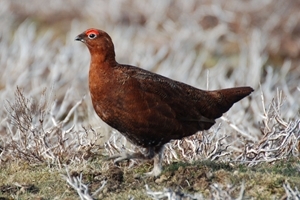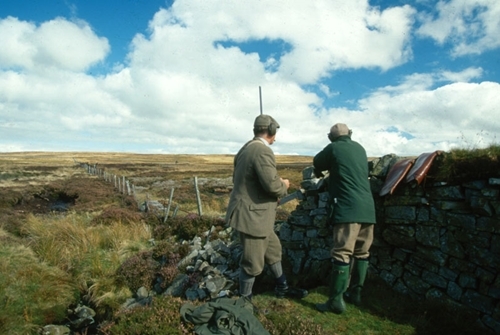 Grouse shooting in the UK occurs in two main forms: driven shooting and walked-up, often over dogs. Driven shooting typically requires higher grouse densities, and this needs more effective management. The scale and impact of this management is the issue that provokes much of the debate around grouse shooting.
Grouse shooting in the UK occurs in two main forms: driven shooting and walked-up, often over dogs. Driven shooting typically requires higher grouse densities, and this needs more effective management. The scale and impact of this management is the issue that provokes much of the debate around grouse shooting.
Q: What are grouse and where are they found?
A: There are four species of grouse in Britain: red grouse, black grouse, capercaillie and ptarmigan. The red grouse population is estimated to be 230,000 pairs, and it is one of this country’s few endemic sub-species, meaning that they are only found in the British Isles. They inhabit heather moorland including areas of both blanket bog and upland heath.
The black grouse population is estimated to be 5,100 males UK-wide. They are found on the moorland fringe and use hill-edge woodlands of both conifer and deciduous species. There are fewer than 2,000 capercaillie in a handful of pine-dominated Scottish woodlands. Ptarmigan live above 800m and, like capercaillie, are also only found in Scotland. Grouse populations tend to fluctuate in size over the years and in relation to management, so these figures are an estimate.
Q: Which grouse are shot on driven grouse moors?
A: Red grouse. They are regarded as the paragon of gamebirds because their speed and agility provides challenging shooting.
Q: Are red grouse wild birds?
A: Yes. Red grouse are entirely wild, unlike many pheasant or partridge shoots, which rely on rearing and releasing birds. Although attempts have been made to rear red grouse, this has not been successful. Grouse management aims to maintain moorland in a high-quality condition for these wild birds.
Q: What is driven grouse shooting?
A: Red grouse, pheasants and partridges are ‘driven’, where birds are flushed by a line of beaters and fly over the people shooting (the ‘Guns’), who are stationary in a line. On grouse moors they typically stand in a line of ‘butts’ – specially constructed shooting positions often built out of wood, stone and turf. Red grouse are also shot ‘walked-up’, where the participants walk across the moorland, flushing birds as they go, often using dogs to find grouse.

Inside a butt, a ‘loader’ prepares the guns for the person shooting (the ‘gun’).
Q: How are driven grouse moors managed?
A: Moorland management for driven grouse shooting includes controlling generalist predators such as crows and foxes; heather management, often by grazing and prescribed burning; and disease control.
Q: Are there benefits of driven grouse shooting over walked-up shooting?
A: Aiming to produce enough grouse to drive means moors have to invest more in staff, time and equipment than where walked-up shooting is the only aim. This allows more consistent, effective predator and disease control, along with habitat management. This greater investment in management has benefits for other moorland wildlife, such as species of ground-nesting birds, and for habitats and the environment. A driven grouse shoot can make this additional investment because the economic returns for driven shooting are much greater than for walked-up shooting.
Q: What are the conservation benefits of driven shooting?
A: Moors managed for red grouse are shown to be better than other land uses in maintaining heather-dominated habitat, and both directly and indirectly support the species that depend on or thrive in it. This is important because 75% of the world’s heather moorland is found in Britain. In addition, many species of upland birds, including curlew, lapwing and golden plover, are more numerous and breed more successfully on moorland managed for red grouse than on other moorland not managed in this way. The way the keepers manage the land is beneficial to these birds, some of which are of conservation concern, and whose populations are declining nationally and internationally.
Q: Are there negative impacts?
A: If the law and best practice guidelines are not followed, there can be negative impacts from practices such as illegal raptor killing or inappropriate burning. Some impacts can be avoided by adherence to the law and best practice guidance, which uses the best available knowledge to avoid or reduce these to acceptable levels.
Q: Are the benefits widely recognised?
A: Yes. In response to the petition to ban driven grouse shooting in 2016, the UK government released a statement recognising that: “When carried out in accordance with the law, grouse shooting for sport is a legitimate activity and in addition to its significant economic contribution, providing jobs and investment in some of our most remote areas, it can offer important benefits for wildlife and habitat conservation”.
Managed heather moorland has been recognised as iconic and archetypal, and the Scottish Cabinet Secretary for Environment, Climate Change and Land Reform has expressed a wish to “…ensure that grouse moor management continues to contribute to the rural economy…”.
The economics of grouse moors
Q: What is the economic value of grouse shooting?
A: A recent report indicated that grouse moor owners in England spend £52.5 million every year on moorland management. The report also indicated that businesses associated with grouse shooting benefit by some £15.2 million every year. These include game dealers, accommodation providers, equipment suppliers, catering establishments and transport operators, often based in remote rural locations who depend on grouse shooting as the main economic driver outside the tourist season. Grouse moors in England support 1,520 Full Time Equivalent (FTE) jobs. 700 are directly involved with grouse moor management and a further 820 jobs in related services and industries.
In Scotland, it was found that there were around 2,500 FTE jobs (both direct and indirect) reliant on the grouse moor sector in 2009 with £14.5 million spent on wages related to grouse moor management and support activities, and a total ‘Gross Value Added’ contribution of £23 million to the Scottish economy. The Scottish Moorland Group reported an average annual wage bill of £210,000 for estates involved in grouse moor management.
Q: What costs are involved in managing moorland for conservation and driven grouse shooting?
A: Some of the main costs are heather management or restoration (such as muirburn, cutting or re-seeding), bracken control, livestock management, predator and deer control, track maintenance, salaries, housing and equipment (e.g. tractors, ATVs).
Q: Can driven grouse shooting cover these costs?
A: The income from driven grouse shooting can make a valuable contribution to the costs of running both moorland and shoot management. If there are enough grouse, then it is possible to cover the costs in a shooting season.
Q: Can these costs be consistently met?
A: No, not always. Even though some of the variability in red grouse numbers from year to year can now be smoothed out using the available management tools such as medicated grit, it is impossible to eliminate the risks. For instance, extreme weather can impact on grouse numbers especially if combined with parasite problems. Grouse are an arctic species and relatively well adapted to cold and wet weather. Where the numbers of grouse drop to levels at which further shooting may risk reducing the desired level of breeding stock for the next year, owners may decide to run a restricted shoot programme, or they might decide to cancel all shooting. So, the income can still vary from year to year, making it difficult to cover the costs of heather habitat and grouse management on a regular basis.
Q: What else can affect the chances of covering management costs?
A: Owners and managers need to ensure that their stock of grouse is sufficient to absorb not only the effect of predators that can be legally controlled, (such as foxes and crows), but also the impact from protected species, particularly raptors. The GWCT’s involvement in projects like the Langholm Moor Demonstration Project and the Hen Harrier Brood Management Scheme is about finding a science-based answer to the conflict between raptors and management for red grouse.
Q: Could walked-up shooting replace driven shooting?
A: Allowing higher density (driven) grouse moors to decline to lower density (walked-up) ones would result in greater loss of income than the corresponding saving, and would not be economically viable, as well as not bringing the same level of conservation benefits.
Q: What might happen if we can’t find a way that allows moor owners a reasonable chance to recover costs on moorland management?
A: If moor owners aren’t given the scope to recover some of the costs of moorland management through driven grouse shooting, this could result in abandonment of grouse management and gamekeepers losing their employment. Losing gamekeepers from the uplands would jeopardize the protection of heather moorland and Special Protection Areas for birds, large areas of which are keepered and which also support high numbers of breeding waders like curlews. If made the responsibility of the public sector, protection of the heather moorland habitat and the conservation benefits that brings would require huge amounts of public funding.